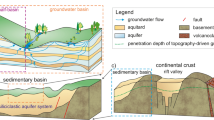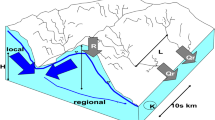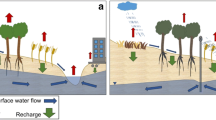Abstract
The theory of regional groundwater flow is critical for explaining heat transport by moving groundwater in basins. Domenico and Palciauskas’s (1973) pioneering study on convective heat transport in a simple basin assumed that convection has a small influence on redistributing groundwater temperature. Moreover, there has been no research focused on the temperature distribution around stagnation zones among flow systems. In this paper, the temperature distribution in the simple basin is reexamined and that in a complex basin with nested flow systems is explored. In both basins, compared to the temperature distribution due to conduction, convection leads to a lower temperature in most parts of the basin except for a small part near the discharge area. There is a high-temperature anomaly around the basin-bottom stagnation point where two flow systems converge due to a low degree of convection and a long travel distance, but there is no anomaly around the basin-bottom stagnation point where two flow systems diverge. In the complex basin, there are also high-temperature anomalies around internal stagnation points. Temperature around internal stagnation points could be very high when they are close to the basin bottom, for example, due to the small permeability anisotropy ratio. The temperature distribution revealed in this study could be valuable when using heat as a tracer to identify the pattern of groundwater flow in large-scale basins. Domenico PA, Palciauskas VV (1973) Theoretical analysis of forced convective heat transfer in regional groundwater flow. Geological Society of America Bulletin 84:3803–3814
Résumé
La théorie du flux souterrain régional est indispensable pour expliquer le transport de chaleur par mouvements d’eau souterraine dans les bassins. Domenico et Palciauskas (1973), pionniers dans l’étude du transport convectif de chaleur dans un bassin simple, assumaient que la convection avait une faible influence sur la redistribution des températures dans un aquifère. De plus, il n’y a pas eu de recherche se focalisant sur la distribution des températures près des zones de stagnation entre différents systèmes de flux. Dans cet article, la distribution des températures dans un bassin simple est réexaminée et de plus, celle d’un bassin complexe avec des systèmes de flux imbriqués est explorée. Dans ces deux bassins pour lesquels la distribution de la température due à la conduction est comparée, la convection entraine une baisse de température dans la plus grande partie du bassin à l’exception d’un petit secteur proche de la zone de décharge. Il existe une anomalie de hautes températures près du point de stagnation en fond de bassin où deux systèmes de flux convergent du fait d’un faible degré de convection et une distance de trajet importante. Par contre, il n’y a pas d’anomalie près du point de stagnation de fond de bassin lorsque deux systèmes de flux divergent. Dans le bassin complexe, il y a également une anomalie de fortes températures vers le point de stagnation interne. La température vers le point interne de stagnation peut être très élevée lorsqu’ils sont proches du fond du bassin du fait, par exemple, d’un faible rapport d’anisotropie de la perméabilité. La distribution de la température montrée dans cette étude peut être intéressante lorsque l’on utilise la chaleur comme un traceur pour identifier les schémas de circulation des flux souterrains dans de grands bassins. Domenico PA, Palciauskas VV (1973) Theoretical analysis of forced convective heat transfer in regional groundwater flow (Analyse théorique du transfert de chaleur par convection sous contraintes dans l’écoulement régional d’eaux souterraines). Geological Society of America Bulletin 84:3803–3814
Resumen
La teoría del flujo regional de agua subterránea es crítica para explicar el transporte del calor por movimiento del agua subterránea en cuencas. El estudio pionero de Domenico y Palciauskas (1973) sobre transporte convectivo de calor en una cuenca simple asumió que la convección tenía una influencia pequeña en la redistribución de la temperatura en el agua subterránea. Más aún, no ha habido ninguna investigación enfocada en la distribución de la temperatura alrededor de las zonas de estancamiento entre los sistemas de flujo. En este trabajo, se reexamina la distribución de la temperatura en la cuenca simple y se explora dicha distribución en una cuenca compleja con sistemas de flujo anidados. Comparada con la distribución de la temperatura debido a la conducción, la convección en ambas cuenca lleva a temperaturas más bajas en la mayor parte de la cuenca excepto para una parte pequeña cercana a la zona de descarga. Existe una anomalía de alta temperatura alrededor del punto de estancamiento en el fondo de la cuenca donde dos sistema de flujo convergen debido a un bajo grado de convección y a una gran distancia de tránsito, pero no existe anomalía alrededor de un punto de estancamiento en el fondo de la cuenca donde dos sistemas de flujo divergen. En la cuenca compleja, también existen anomalías de alta temperatura alrededor de puntos internos de estancamiento. La temperatura alrededor de los puntos internos de estancamiento podría ser muy alta cuando ellos están cercanos al fondo de la cuenca, por ejemplo, debido a una baja relación entre permeabilidad y anisotropía. La distribución de temperatura revelada en este estudio podría ser valiosa al utilizar el calor como un trazador para identificar el esquema del flujo de agua subterránea en cuencas a gran escala. Domenico PA, Palciauskas VV (1973) Theoretical analysis of forced convective heat transfer in regional groundwater flow (Análisis teórico de la transferencia de calor por convección forzada en el flujo regional de agua subterránea). Geological Society of America Bulletin 84:3803–3814
摘要
区域地下水流理论对解释盆地内依靠地下水流动的热量传输过程至关重要。Domenico 和 Palciauskas (1973年)对一个简单盆地进行热对流传输的开拓性研究中, 假定对流对地下水温度的再分布影响很小。此外,对水流系统中滞流区周围的的温度分布还没有研究过。本文中,重新研究了简单盆地的温度分布规律,并对拥有多级次水流系统的复杂盆地进的温度分布规律开展了研究。在这两种盆地中,与传导造成的温度分布相比,除了排泄区附近很小一片区域外,对流将会使流域大部分地区的温度偏低。在两个水流系统汇聚的盆地底部驻点周围,由于对流程度较低及流动距离很长,存在着一个高温异常,但在两个水流系统分岔的盆地底部驻点周围,没有高温异常。在复杂盆地中,内部驻点周围也有高温异常。当内部驻点靠近盆地底部时,例如,由于渗透性各向异性比值很小,其周围的温度可能非常高。在利用温度作为示踪剂确定大尺度盆地地下水水流模式时,本研究所揭示的温度分布规律非常有价值。Domenico PA, Palciauskas VV (1973年),Theoretical analysis of forced convective heat transfer in regional groundwater flow (区域地下水流中强迫性对流热量转移的理论分析)。美国地质学会学报 84:3803–3814
Resumo
A teoria do fluxo de água subterrânea regional é crítica para explicar o transporte de calor através do movimento da água subterrânea nas bacias. O estudo pioneiro de Domenico e Palciauskas (1973) sobre transporte de calor convectivo numa bacia simples assumiu que a convecção tem uma influência diminuta na redistribuição da temperatura da água subterrânea. Para além disso, não tem havido pesquisa vocacionada para a distribuição de temperatura em redor de zonas de estagnação dentro dos sistemas de fluxo. Neste documento, a distribuição de temperatura na bacia simples é reexaminada e é explorada a mesma situação numa bacia complexa com sistemas de fluxo aninhados. Em ambas as bacias, em comparação com a distribuição de temperaturas devidas a condução, a convecção leva a temperaturas mais baixas na maior parte das bacias, exceto em pequenas zonas próximas das áreas de descarga. Existe uma grande anomalia de alta temperatura em redor do ponto de estagnação na base da bacia, onde dois sistemas de fluxo convergem devido ao baixo grau de convecção e à longa distância de circulação, mas não há anomalia em redor do ponto de estagnação da base da bacia onde os dois sistemas de fluxo divergem. Na bacia complexa existem também anomalias de alta temperatura em redor de pontos de estagnação internos. A temperatura em redor de pontos de estagnação internos pode ser muito elevada quando estes estão próximos da base da bacia, por exemplo devido a pequenos efeitos anisotrópicos na permeabilidade. A distribuição de temperatura revelada neste estudo pode ser valiosa quando se usa o calor como traçador para identificar o padrão de fluxo da água subterrânea em bacias a grande escala. Domenico PA, Palciauskas VV (1973) Theoretical analysis of forced convective heat transfer in regional groundwater flow [Análise teórica de transferência de calor convectivo forçado em fluxos regionais de água subterrânea]. Geological Society of America Bulletin 84:3803–3814








Similar content being viewed by others
References
Anderson MP (2005) Heat as a ground water tracer. Ground Water 43(6):951–968
Bear J (1972) Dynamics of fluids in porous media. Elsevier, New York
Bravo HR, Feng J, Hunt RJ (2002) Using groundwater temperature data to constrain parameter estimation in a groundwater flow model of a wetland system. Water Resour Res 38(8):1153. doi:10.1029/2000WR000172
Domenico PA, Palciauskas VV (1973) Theoretical analysis of forced convective heat transfer in regional groundwater flow. Geol Soc Am Bull 84:3803–3814
Domenico PA, Schwartz FW (1998) Physical and Chemical Hydrogeology, 2nd edn. John Wiley & Sons, New York
Freeze RA, Witherspoon PA (1967) Theoretical analysis of regional groundwater flow: 2. effect of water-table configuration and subsurface permeability variations. Water Resour Res 3:623–634
Hatch CE, Fisher AT, Revenaugh JS, Constantz J, Ruehl C (2006) Quantifying surface water–ground water interactions using time series analysis of streambed thermal records: method development. Water Resour Res 42(10), W10410
Ingebritsen SE, Sanford WE, Neuzil CE (2006) Groundwater in geological processes, 2nd edn. Cambridge Univ. Press, Cambridge
Jiang XW, Wang XS, Wan L, Ge S (2011) An analytical study on stagnant points in nested flow systems in basins with depth-decaying hydraulic conductivity. Water Resour Res 47(1), W01512
Jiang XW, Wan L, Ge S, Cao GL, Hou GC, Hu FS, Wang XS, Li H, Liang SH (2012) A quantitative study on accumulation of age mass around stagnation points in nested flow systems. Water Resour Res 48(12), W12502
Jiang XW, Wan L, Wang JZ, Yin BX, Wu F, Lin CH (2014) Field identification of groundwater flow systems and hydraulic traps in drainage basins using a geophysical method. Geophys Res Lett 41(8):2812–2819
Lapham WW (1989) Use of temperature profiles beneath streams to determine rates of vertical groundwater flow and vertical hydraulic conductivity. US Geol Surv Water Supply Pap 2337
Lazear GD (2006) Evidence for deep groundwater flow and convective heat transport in mountains terrain, Delt Country, Colorado, USA. Hydrogeol J 14(8):1582–1598
Macfarlane PA, Forster DF, Merrian J (2002) Monitoring artificially stimulated fluid movement in the Cretaceous Dakota aquifer, western Kansas. Hydrogeol J 10(6):662–673
Pinder GF, Gray W (1977) Finite element simulation in surface and subsurface hydrology. Academic, New York
Prudic DE, Niswonger RG, Wood JL, Henkelman KK (2003) Trout Creek: estimating flow duration and seepage losses along an intermittent stream tributary to the Humboldt River, Lander and Humboldt counties, Nevada. In: Stonestrom DA, Constantz J (eds) Heat as a tool for studying the movement of groundwater near streams. US Geol Surv Circ 1260, pp 81–89
Saar MO (2011) Geothermal heat as a tracer of large-scale groundwater flow and as a means to determine permeability fields. Hydrogeol J 19:31–52
Sass JH, Lachenbruch AH, Munroe RJ (1971) Thermal conductivity of rocks from measurements on fragments and its application to heat-flow determinations. J Geophys Res 76:3391–3401
Smith L, Chapman DS (1983) On the thermal effects of groundwater flow–regional scale systems. J Geophys Res 88(B1):593–608
Sorey ML (1978) Numerical modeling of liquid geothermal systems. US Geol Surv Prof Pap 1044-D
Stallman RW (1963) Computation of groundwater velocity from temperature data. In: Methods of collecting and interpreting groundwater data. US Geol Surv Water Suppl Pap 1544-H:36–46
Stallman RW (1965) Steady one-dimensional fluid flow in a semi-infinite porous medium with sinusoidal surface temperature. J Geophys Res 70(12):2821–2827
Su GW, Jasperse J, Seymour D (2004) Estimation of hydraulic conductivity in an alluvial system using temperatures. Ground Water 42(6):890–901
Suzuki S (1960) Percolation measurements based on heat flow through soil with special reference to paddy fields. J Geophys Res 65(9):2883–2885
Tóth J (1962) A theory of groundwater motion in small basins in central Alberta, Canada. J Geophys Res 67(11):4375–43787
Tóth J (1963) A theoretical analysis of groundwater flow in small drainage basins. J Geophys Res 68:4795–4812
Tóth J (1999) Groundwater as a geologic agent: an overview of the causes, processes, and manifestations. Hydrogeol J 7(1):1–14
Tóth J (2009) Gravitational systems of groundwater flow: theory, evaluation and utilization. Cambridge Univ. Press, Cambridge
Wang K, Shen PY, Beck AE (1989) A solution to the inverse problem of coupled hydrological and thermal regimes. In: Beck AE, Garven G, Stegena L (eds) Hydrogeological regimes and their subsurface thermal effects. Geophysical Monograph Series, vol 47. AGU, Washington, DC, pp 477–522
Wang XS, Jiang XW, Wan L, Ge S, Li H (2011) A new analytical solution of topography‐driven flow in a drainage basin with depth‐dependent anisotropy of permeability. Water Resour Res 47(9), W09603
Zlotnik VA, Cardenas MB, Toundykov D (2011) Effects of multiscale anisotropy on basin and hyporheic groundwater flow. Ground Water 49(4):576–583
Acknowledgements
This study was supported by the Fok Ying Tung Education Foundation (141015), the Program for New Century Excellent Talents in Universities (NCET-13-1007), and partially by the Foundation for the Advisor of Beijing Excellent Doctoral Dissertation (20121141502) and the Beijing Higher Education Young Elite Teacher Project (YETP0656). The authors acknowledge three reviewers, Mark Person, Grant Ferguson and Andrew Fisher, and the editor, Jiu Jimmy Jiao, who have significantly enhanced the quality of this manuscript.
Author information
Authors and Affiliations
Corresponding author
Rights and permissions
About this article
Cite this article
An, R., Jiang, XW., Wang, JZ. et al. A theoretical analysis of basin-scale groundwater temperature distribution. Hydrogeol J 23, 397–404 (2015). https://doi.org/10.1007/s10040-014-1197-y
Received:
Accepted:
Published:
Issue Date:
DOI: https://doi.org/10.1007/s10040-014-1197-y




